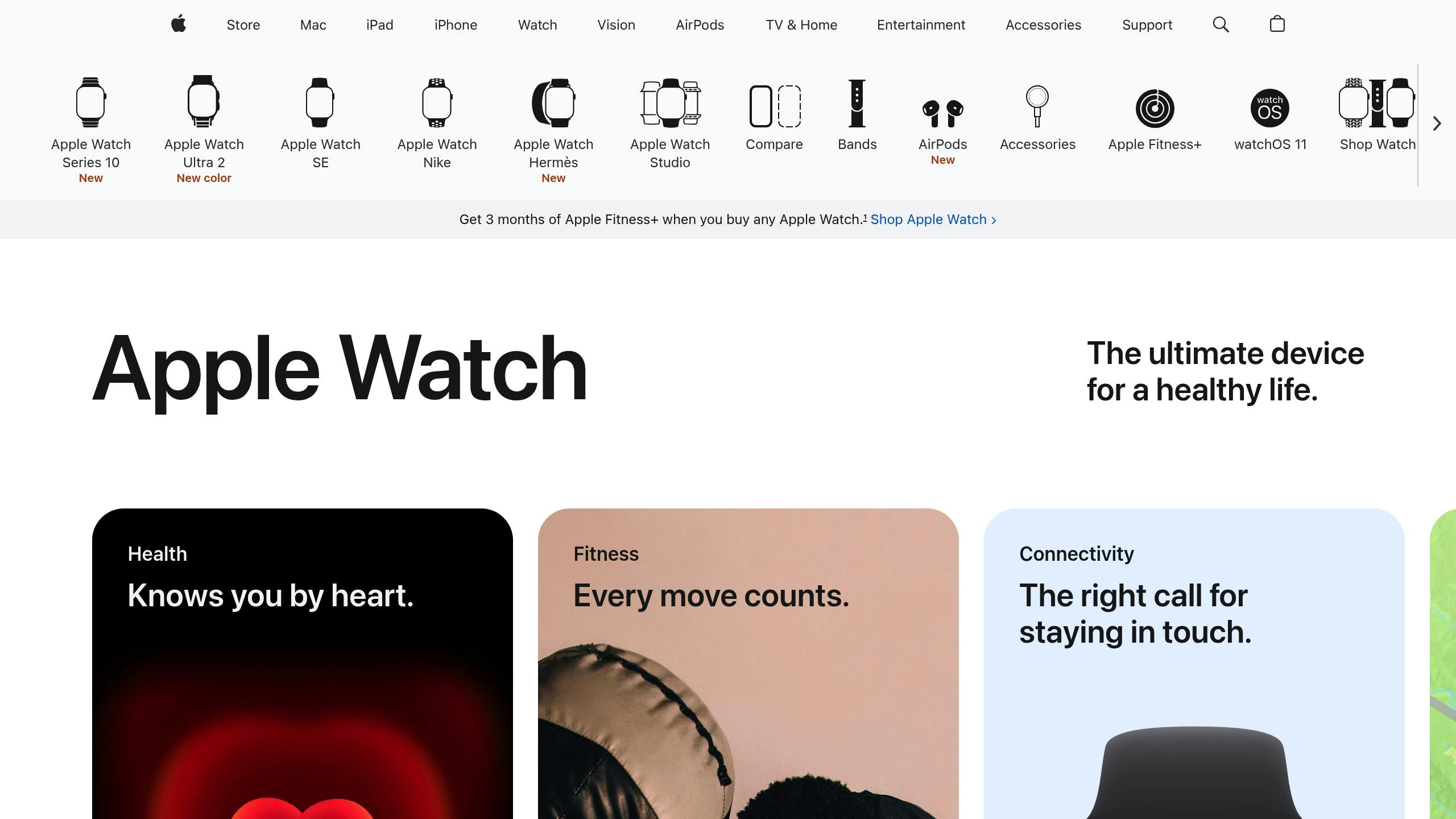Apple Watch Water Resistance Ratings: What to Know

Apple Watches are water-resistant, not waterproof, and their capabilities vary by model. Here's what you need to know:
- Series 1 and 1st Gen: Splash-resistant (IPX7), not for swimming.
- Series 2-6, 7-9, SE: Water-resistant up to 50 meters (5 ATM), suitable for swimming and shallow-water activities.
- Ultra and Ultra 2: Water-resistant up to 100 meters (10 ATM), supports recreational diving (up to 40 meters), and high-speed water sports.
Quick Comparison
| Model | Water Resistance | Maximum Depth | Dust Rating |
|---|---|---|---|
| Series 1, 1st Gen | IPX7 | 1 meter | None |
| Series 2-6 | 50 meters (5 ATM) | 50 meters | None |
| Series 7-9, SE | 50 meters (5 ATM) | 50 meters | IP6X |
| Ultra, Ultra 2 | 100 meters (10 ATM) | 100 meters | IP6X |
Key Tips:
- Water resistance can weaken over time due to wear, heat, or chemical exposure.
- Avoid exposing your watch to saunas, soaps, or high-pressure water.
- Always rinse and dry your Apple Watch after water exposure to maintain its resistance.
For detailed care instructions and activity guidelines, read on.
Apple Watch Ultra vs Series 10: Which is Better for Swimmers?

Water Resistance Levels by Apple Watch Model

Knowing your Apple Watch's water resistance rating helps you understand which water-related activities are safe for your device. Each model offers varying levels of protection, with newer versions designed for broader use.
Water Ratings: Series 1 to Ultra
| Model | Water Resistance Rating | Maximum Depth | Dust Rating |
|---|---|---|---|
| Series 1, 1st Gen | IPX7 | 1 meter for 30 min | None |
| Series 2-6 | 50 meters (5 ATM) | 50 meters | None |
| Series 7-9, SE | 50 meters (5 ATM) | 50 meters | IP6X |
| Ultra, Ultra 2 | 100 meters (10 ATM) | 100 meters | IP6X |
The Series 1 models are splash-resistant (IPX7) but not designed for swimming. On the other hand, the Ultra models offer a 100-meter water resistance rating and are certified for recreational diving (EN13319) [3][5]. These ratings define what activities each model can handle safely.
Safe Water Activities by Model
Series 1 and First Generation:
- Suitable for splashes, rain, and handwashing
- Not designed for swimming or showering
Series 2 through 9 and SE:
- Can handle pool and ocean swimming
- Ideal for shallow water activities and showering (avoid soap contact)
- Safe for water sports without high-speed impact
Ultra and Ultra 2:
- Includes all activities supported by earlier models
- Allows recreational diving up to 40 meters [3]
- Handles high-velocity water sports
- Supports prolonged submersion
The Ultra models stand out with their ability to handle deeper dives and more intense water activities, while standard models are best suited for surface-level swimming and everyday water exposure.
Limits of Water Resistance
Although earlier Apple Watch models allow for swimming and even diving, they come with some important limitations. Water resistance can weaken over time due to regular use, exposure to chemicals, and extreme temperatures. Here are the key factors to consider:
Temperature Effects: Extreme heat or cold can damage the water seals. Hot environments, like saunas, may cause the seals to expand, while cold temperatures can make them brittle [2].
Chemical Exposure:
- Chlorine: Can harm the rubber seals.
- Soap and Shampoo: May weaken the adhesives.
- Salt Water: Can corrode metal components.
- Sunscreen: Can break down the materials over time.
Activities That Can Cause Water Damage
Even with water resistance ratings, some activities can still put your Apple Watch at risk:
High-Pressure Water Sports: Activities such as water skiing or jet skiing expose the watch to water pressure beyond its resistance capabilities [1].
Steam and Heat: Apple advises against using the watch in saunas or steam rooms, as the heat and moisture can damage the seals [1][2].
If you notice signs like condensation under the screen, muffled audio, an unresponsive touch screen, or visible water inside the device, take immediate steps to dry it out (details covered later). For ongoing problems, it's best to reach out to Apple Support [1].
sbb-itb-f6ade85
Keeping Your Apple Watch Water-Safe
Protecting your Apple Watch from water damage involves regular care and attention, especially after it’s been exposed to water. Following the right steps can help maintain its water-resistant features and keep it functioning properly.
After-Water Care Steps
Taking care of your Apple Watch after water exposure is key. Here’s what you should do:
Immediate Care
- Use the Water Lock feature by turning the Digital Crown to eject water from the speaker [1].
- Rinse the watch with fresh water if it has been exposed to saltwater, chlorine, or chemicals [2].
- Dry it thoroughly with a soft, lint-free cloth that won’t scratch the surface [1].
Additional Protection
- Wait at least an hour before charging the watch after water exposure [2].
- Check the charging port to ensure it’s completely dry before connecting a charger [2].
- Avoid drying the watch with heat sources or compressed air, as these can cause damage [1].
Best Straps for Water Use
The strap you use can make a big difference when it comes to water activities. Here’s a quick breakdown of some water-friendly options:
| Strap Type | Best For | Features |
|---|---|---|
| Silicone Sport | Swimming, intense water sports | Quick-drying, durable |
| Nylon NATO | Beach activities, casual water use | Breathable, comfortable |
| Magnetic Silicone | General water activities | Secure fit |
For example, Friday’s Silicone Sport Band, rated 4.7 stars, is a great choice for resisting water and drying quickly [3].
Key Tips:
- Replace straps that show wear and tear to ensure proper water resistance.
- Clean your straps thoroughly after exposure to saltwater or chlorinated water to prevent damage.
Conclusion: Water Resistance Guidelines
Now that you understand your watch's limits and care needs, here are some practical tips to keep it in top condition:
Match Your Watch to the Right Activities
Each watch model is designed for specific water-related activities. For instance, Series 1 and 1st Generation watches can handle light splashes or rain [1][3]. On the other hand, Series 2 and later models are suitable for swimming in pools or the ocean [1][3].
Protect Your Watch in Water
Here are some easy ways to keep your watch safe:
- Use Ultra models for diving and standard models for swimming.
- Stay away from chemicals like chlorine and avoid exposing your watch to extreme temperatures.
- Always rinse and dry your watch after water exposure.
- Inspect the seals annually to ensure they remain intact.
- Replace worn or damaged straps promptly to maintain water resistance.
Maintenance Tips
- Check the water seals every 6–12 months to ensure they’re functioning properly.
- Avoid exposing your watch to soaps, perfumes, or other chemicals that can damage seals.
- Rinse and dry your watch after every water activity to prevent residue buildup.
Long-Term Care
To extend your watch’s lifespan, avoid exposing it to extreme heat or strong impacts, as outlined in the Limits of Water Resistance section. Consider using water-friendly straps like silicone for added comfort and quicker drying.
Keep an eye out for signs of trouble, such as screen fogging, which may indicate damaged seals. If this happens, take your watch to a professional for inspection immediately [3][4].
FAQs
Is the Apple Watch Ultra 2 waterproof?
The Apple Watch Ultra 2 is rated water-resistant up to 100 meters, but it’s not entirely waterproof. It’s certified for recreational diving and can handle scuba diving up to 40 meters. However, keep in mind that water resistance can diminish over time [6]. For tips on maintaining your watch after diving, check the After-Water Care section above.
Is the Series 9 Apple Watch waterproof?
The Series 9 Apple Watch is water-resistant up to 50 meters (ISO 22810:2010), making it suitable for swimming, but it’s not waterproof [4]. To maintain its water resistance, follow proper care steps after swimming - details are available in the Keeping Your Apple Watch Water-Safe section.
How deep can an Apple Watch go underwater?
Apple provides the following guidelines:
- Standard models: Best for surface swimming.
- Ultra models: Suitable for diving up to 40 meters [3][6].
These ratings are based on controlled lab tests. In real-world conditions, it’s crucial to stay within the recommended depth and activity limits for your specific model.









